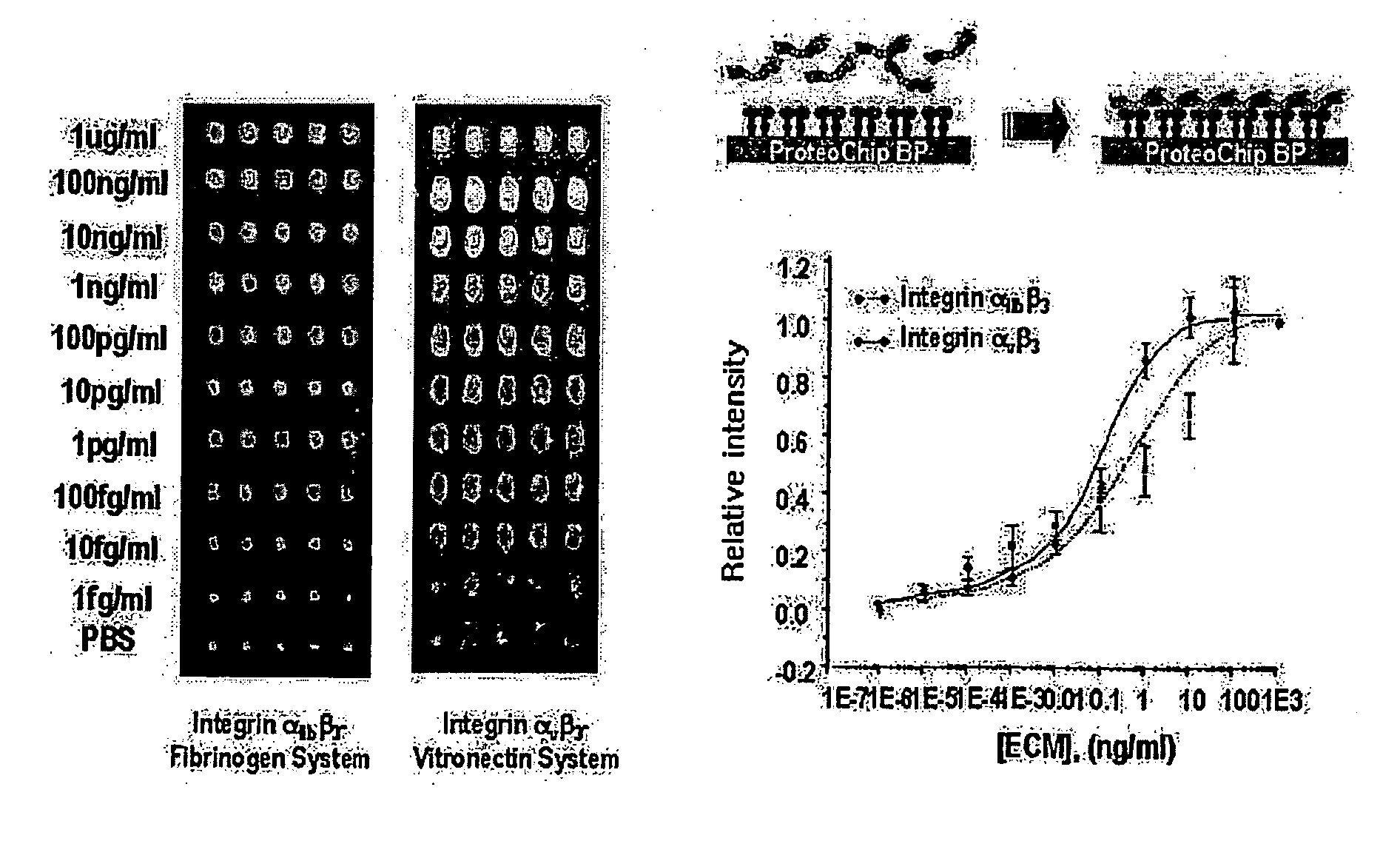High-Throughput Screening Method for Intergrin Antagonist and New Peptide Screened Therefrom
a screening method and peptide technology, applied in the field of high-throughput screening methods for intergrin antagonists and new peptides screened therefrom, can solve the problem of inadequacies of methods for large screening
- Summary
- Abstract
- Description
- Claims
- Application Information
AI Technical Summary
Benefits of technology
Problems solved by technology
Method used
Image
Examples
example 1
Immobilization of Integrin Receptor on Protein Chip
[0027] ProteoChip™ (Proteogen, Inc., Seoul, South Korea) was used as a protein chip and integrins were spotted on the ProteoChip™ (Proteogen, Inc., Seoul, South Korea) with the microarrayer (CM-1000; Proteogen, Inc., Seoul, South Korea) to fabricate integrin receptor microarray (See Lee, Y. S. et al.: ProteoChip: a highly sensitive protein microarray proposed by a novel method of protein immobilization for application of protein-protein interaction studies, Proteomics 2003; 3: 2289-2304). Integrin α11bβ3 was purified to homogeneity by GRGDSPK-Sepharose column chromatography from the platelet (See Kang I. C. and Kim D. S., Analysis of potent glycoprotein IIb-IIIa antagonist from natural sources. J Biochem Mol Biol 1998; 31: 515-518), and Integrin αvβ3 was commercially obtained from Chemicon International, Inc. (CA, USA).
[0028] Integrins (40 μg / mL) diluted with a phosphate-buffered saline (PBS) solution containing 10 mM β-octylthiog...
example 2
Integrin-Ligand Interaction Assay Using Integrin Microarray
[0029] The ligand proteins (fibrinogen or vitronectin; Chemicon International, Inc., USA) labeled with fluorescence (Cy-5 or Cy-3; Amersham-Pharmacia Biotech, USA) were spotted with the microarrayer on the integrin-binding protein chip prepared in Example 1 in different concentrations ranging from 1 μg / ml to μg / ml, and then incubated in a oven of 37° C. and over 75% humidity for 1 hour. After washing by immersing in 0.5% PBST for 10 minutes, results of integrin-ligand interaction were measured by a fluorescence scanner.
[0030] Relative intensities of fluorescence according to the concentrations were shown as linear in graph, from which the detection limit is shown to be at a concentration of 1 fg / ml (See FIG. 2).
example 3
Binding Inhibition Assay of Integrin α11bβ3-Fibrinogen Interaction by Antagonistic Materials of Integrin
[0031] Mixtures of ligand protein (fibrinogen 100 ng / ml) labeled with fluorescence (Cy-5) and known integrin antagonists such as disintegrins (echistatin 250 μg / ml, flavoridin 250 μg / ml, kistrin 250 μg / ml, and salmosin 2.6 ng / ml), a monoclonal antibody (mAb) against integrin 1.0 mg / ml, and various concentrations of synthetic RGD peptides (echistatin, flavoridin, kistrin: Sigma-Aldrich, USA; Salmosin: isolated and purified from recombinant E. Coli; monoclonal antibody against integrin: Chemicon International, Inc., USA; synthetic. RGD peptides: synthesized in the Korea Research Institute of Bioscience and Biotechnology, South Korea) were dropped on the integrin receptor of integrin α11bβ3-binding protein chip prepared in Example 1 by using micropipette or microarrayer (CM-1000; Proteogen, Inc., Seoul, South Korea) and then were reacted in a oven of 37° C. and over 75% humidity for...
PUM
| Property | Measurement | Unit |
|---|---|---|
| concentrations | aaaaa | aaaaa |
| concentration | aaaaa | aaaaa |
| concentrations | aaaaa | aaaaa |
Abstract
Description
Claims
Application Information
 Login to View More
Login to View More - R&D
- Intellectual Property
- Life Sciences
- Materials
- Tech Scout
- Unparalleled Data Quality
- Higher Quality Content
- 60% Fewer Hallucinations
Browse by: Latest US Patents, China's latest patents, Technical Efficacy Thesaurus, Application Domain, Technology Topic, Popular Technical Reports.
© 2025 PatSnap. All rights reserved.Legal|Privacy policy|Modern Slavery Act Transparency Statement|Sitemap|About US| Contact US: help@patsnap.com



